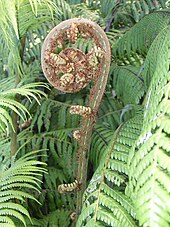Cyathea dealbata
| Silver fern | |
|---|---|
 | |
| Frond, showing silver underside | |
| Scientific classification | |
| Kingdom: | Plantae |
| Division: | Pteridophyta |
| Class: | Pteridopsida |
| Order: | Cyatheales |
| Family: | Cyatheaceae |
| Genus: | Cyathea |
| Subgenus: | Cyathea |
| Section: | Alsophila |
| Species: | C. dealbata |
| Binomial name | |
| Cyathea dealbata (G. Forster) Swartz, 1801 | |
| Synonyms | |
| |
Cyathea dealbata, also known as the silver tree-fern[1] or silver fern, or as ponga /ˈpɒŋə/ or punga /ˈpʌŋə/ (from Māori kaponga or ponga), is a species of medium-sized tree fern, endemic to New Zealand.[2] It is a symbol commonly associated with the country both overseas and by New Zealanders themselves.[3]
This fern is known to grow to heights of 10 m or more (though it occasionally takes a rare creeping form). The crown is dense, and the frondstend to be about 4 m long and have a silver-white colouration on the undersides. This distinctive silver colouration has made them useful for laying along tracks for night walking. The scales are a dark brown and are often twisted and glossy.[4]
Arriving relatively late in New Zealand's history during the Pliocene epoch[5] (around 5.0–1.8 million years ago), the silver fern occurs on the main islands of New Zealand and on the Chatham Islands to the east, mostly in the subcanopy areas of drier forests and in open scrub. It is known to grow well in well-drained humus, and once established, it will tolerate drier conditions. It does best when sheltered from winds and should be protected from frost.
In culture[edit]
- The earliest use of the silver fern as an official national symbol was by the New Zealand Army during the Second Boer War. Since then, the silver fern has been used by the New Zealand Expeditionary Forces during both World Wars and all Commonwealth war graves of fallen New Zealand soldiers have the silver fern engraved on their tombstones. During the 1956 Suez Crisis, Egyptians took exception to New Zealand and Canadian peacekeepers having the Union Flag on their uniforms. Canadian troops wore the Maple Leaf whereas the New Zealand contingent wore a silver fern symbol. New Zealand peacekeepers have since used both the silver fern and kiwi symbols for different deployments to differentiate from their Australian and British counterparts.
- The silver fern has long been used on dairy products, including the logo of New Zealand Natural, and was trademarked as early as 1885.
- Silver fern leaves appear on the coat of arms of New Zealand.
- It is a logo for many other organisations, such as (heavily stylised) the rail operator KiwiRail. The Silver Fern is also the name of a class of railcar.
- Many New Zealanders get a tattoo of a Silver Fern, as a statement of being from New Zealand.[citation needed]
- Some alternative flags for New Zealand, such as the silver fern flag, use the silver fern. The official proposal of the New Zealand flag referendums, 2015–16 featured the fern.
- The silver fern is also used extensively within politics and printed material, such as the logo of the former New Zealand Progressive Party.
- The koru symbol is inspired by the shape of an unfurling silver fern frond. It is found extensively in Māori art, from carving to the official Māori flag and is used in a stylised form as the logo for national airline Air New Zealand.
In short, the fern has become one of the most widely recognised symbols of New Zealand, next to the Kiwi, though it is not an official symbol.[3]








No comments:
Post a Comment